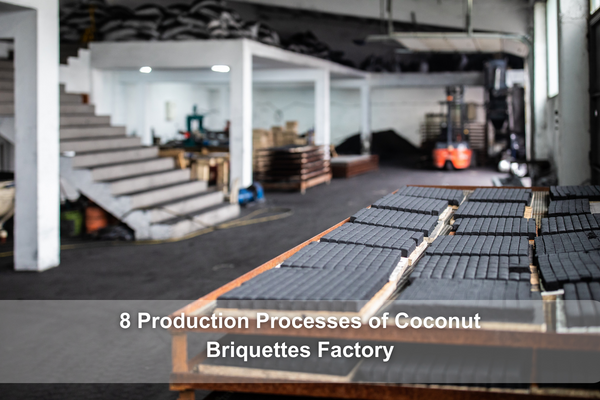Coconut briquettes factory is becoming the latest pioneer to develop renewable energy by utilizing coconut shell waste as its raw material source. The manufacturing process of factory coconut briquettes is a blend of practical skills and sustainable innovation that transforms waste into renewable energy.
This article will elaborate on the product process from coconut shells to eco-friendly briquettes.
From Coconut Briquettes Factory to Eco-Friendly Briquettes
The coconut briquette production process involves several crucial steps that contribute to the quality of the final product and, subsequently, its market demand. Let’s delve into the intricacies of these production processes, highlighting the journey from coconut shells to the creation of environmentally conscious briquettes.
This article will elaborate on the product process from coconut shells to eco-friendly briquettes.
Coconut Briquettes Factory Production Process
Do you know about the coconut briquettes factory? It requires a lot of coconut shell raw materials to go through all the production processes. Also, the quality of the product will depend on the process, then it will affect the amount of coconut charcoal briquette buyers. So, what are the production processes? Here’s the full discussion
Raw Material Collection
The first process is to collect a large amount of coconut shells, the coconut processing industry or farms are the source of raw material collection. Coconut farmers will collect the shells from their fields and deliver the shells to the factory.
Coconut shell raw material collection is an essential step in the production process at the factory. With a regular supply, the factory can continue to carry out a sustainable process.
In this collection process, all farmers or industries must also make a full commitment to always provide high-quality materials, before the officers transport the goods to the factory, they must check the quality of the raw materials.
Sorting and Cleaning
At the factory, the coconut shells undergo a sorting and cleaning stage. The factory will remove unwanted materials such as soil and other fragments, to maintain the optimality of the production process.
After the shell is cleaned from small fragments, usually the factory will immediately cut it into small pieces to facilitate the next process.
Carbonization
The carbonization process is the process of heating at high temperature to convert it into activated charcoal. This process minimizes non-carbon materials such as hydrogen, oxygen, and nitrogen. This process takes a long time, the temperature must also be stable in order not to hinder the ongoing heating process.

It is important to note that various factors, including the temperature, time, and used carbonization method can affect the characteristics of the carbonized charcoal. Therefore, manufacturers should conduct further research and careful testing to obtain charcoal of the desired quality.
Grinding and Sizing
The next process is to grind and shape the material into powder with a grinding machine, and the result can reach a consistent particle size. This process is important for the briquettes to have uniform burning characteristics.
Mixing and Gluing
The next process is to mix the biochar powder with a natural adhesive agent, such as tapioca starch or starch, to form a homogeneous mixture. Once the mixing is complete, it is on to the gluing stage to create a moldable material.
Briquette Forming
Briquette formation is a process where all materials that have gone through many stages up to grinding, will be pressed in a container that already has the desired shape and density.
In this process, the manufacturer needs to ensure that the forming tool has a high pressing force, so that all materials can go through the forming with maximum effort.
Drying
The newly formed briquettes will eventually complete the drying stage to remove any moisture that may remain. The coconut briquettes factory needs to dry the briquettes at high temperatures or in specialized spaces.
Packing and Distribution
After the drying stage is complete, the factory packs the briquettes appropriately for distribution. The factory can also ensure each package complies with quality standards before consumers receive the product.
From all of the above production steps, it turns out that the process requires quite long stages. That way, production costs can also affect the coconut charcoal briquette price. There’s also an Indonesian charcoal supplier who markets at quite competitive prices.
Conclusion
The production process of a coconut briquette factory is a concrete example of the application of the circular economy concept, where there is a process of converting waste into valuable resources.
By carefully planning all processes, the coconut briquette plant has succeeded in creating an eco-friendly and sustainable product, making a positive contribution to global eco-challenges.
By continuously optimizing technology and product practices, the coconut briquette plant is becoming an essential part of the change towards a more sustainable and cleaner future.






